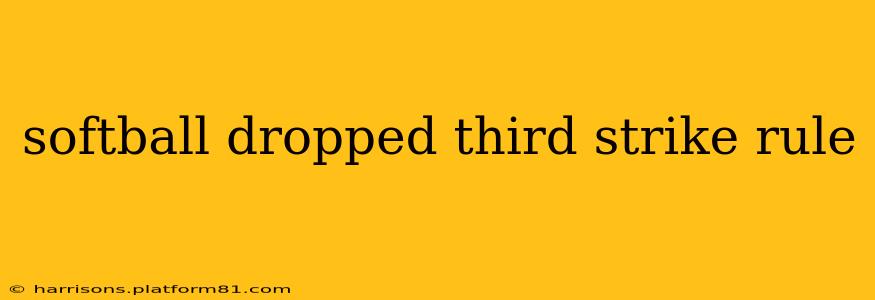The dropped third strike rule in softball is a frequently debated topic, causing confusion for players, coaches, and umpires alike. This comprehensive guide will clarify the rule, address common misconceptions, and answer frequently asked questions to provide a complete understanding of this important aspect of the game.
What is the Dropped Third Strike Rule in Softball?
In softball, a batter is considered out on a dropped third strike only under specific circumstances. If the catcher drops the third strike, the batter is not automatically out. Instead, the batter is only out if one of the following conditions is met:
- The batter attempts to run to first base. If the batter makes any attempt to run after the third strike is dropped, they are considered out. This includes even a slight movement towards first base.
- The umpire calls the batter out. The umpire has the discretion to call the batter out even if they don't attempt to run, although this is less common and generally occurs only if the umpire deems the batter's inaction to be a clear attempt to deceive.
If neither of these conditions occurs, the batter is awarded first base. This is often referred to as a "dropped third strike, live ball." The umpire will announce "Ball one" to the next batter, signalling that the runners can advance if the situation allows for it. The batter who dropped the third strike now becomes a runner on first base.
Why is the Dropped Third Strike Rule in Softball Different from Baseball?
Unlike baseball, where a dropped third strike automatically results in a dead ball and allows the batter to advance to first base only, softball's rule presents an additional out opportunity for the defense. This difference stems from the strategic variations between the two sports. Softball often emphasizes more aggressive base running, and this rule adds another layer of tactical complexity to the game.
How Does the Dropped Third Strike Rule Impact Gameplay?
The dropped third strike rule significantly impacts gameplay by influencing both offensive and defensive strategies. Offensively, batters must carefully consider their actions after a dropped third strike. Running to first base presents an opportunity to advance, but it also carries the risk of being thrown out. The decision to run or not will often depend on the score, the inning, and the presence of runners on base.
Defensively, the catcher must be aware of their responsibilities. While securing the strike is crucial, it's equally important to quickly and efficiently tag the runner out if they try to advance. The infielders also play a vital role in covering first base and making a play on the batter if they attempt to run.
What Happens if the Catcher Drops the Third Strike and the Batter Doesn't Run?
If the catcher drops the third strike, and the batter remains at the plate without any attempt to run, the batter is typically awarded first base. However, the umpire retains the authority to call the batter out if they believe the batter deliberately avoided running to gain an advantage. This is rare and heavily dependent on the umpire's interpretation of the batter's intent.
Can the Umpire Call the Batter Out Even if They Don't Run?
Yes, the umpire has the discretion to call the batter out even if they don't attempt to run. This scenario is less common, and it only occurs if the umpire believes the batter's inaction was a deliberate attempt to deceive or gain an unfair advantage. This often involves the batter showing no visible intent to move and/or an unusual delay in their reaction after the dropped third strike.
What if the ball gets away from the catcher, but it’s not considered a dropped third strike?
If the ball gets away from the catcher for reasons not directly related to catching the third strike (e.g., a wild pitch), then the batter is considered a runner and can advance to first base. However, the ball is live, and runners on base may attempt to advance while the batter remains at the plate. This is a different scenario from a dropped third strike.
This comprehensive explanation of the dropped third strike rule in softball should resolve common confusion and provide a clear understanding of its impact on gameplay. Remember, while the rule's mechanics are straightforward, its application necessitates careful observation and judgment from both players and umpires.
